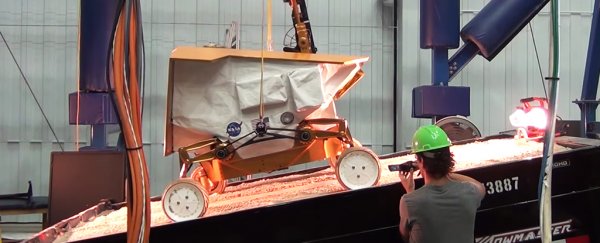Rovers capable of producing their own water could one day be trundling across the Moon's surface, based on plans now being put together by NASA.
Engineers are finalising the design of a Lunar Resource Prospector, which is intended to trawl the Moon's surface in the next decade and hunt for water. Once it's up and running, the rover could play a vital role in establishing a long-term base on the Moon.
The Lunar Resource Prospector is part of NASA's in-situ resource utilisation (ISRU) strategy – using the resources found on other planets and moons to support life and build habitats, rather than having to ferry everything to and from Earth.
And it makes a lot of sense if you think about it: we can't seriously hope to colonise Mars if settlers have to wait for monthly grocery deliveries from their home planet. Any colonising groups will need to be self-sufficient as early as possible.
"Harvesting consumables and fuel off of Earth is an important step in truly pioneering space," NASA explains.
"Just like great pioneers of the past, humans settling deep space must be able to produce or source their food and fuel wherever they may be, whether on the Moon, the moons of Mars, or on the Red Planet itself."
Once the Lunar Resource Prospector arrives on the Moon, the solar-powered rover will look for water, hydrogen, and other volatiles hiding below the lunar surface, prospecting just like humans have done for thousands of years – only with much better technology.
Key to that technology are neutron and infrared spectrometers, using energy and light measurements to determine what the soils and rocks of the Moon are made of.
By drilling down below the lunar soil and heating samples collected in its own built-in oven, the Prospector will be able to determine the level of chemicals present and, if possible, extract water from them.
Provided everything goes as planned, scientists watching back on Earth will be able to see water produced on another planet for the first time ever.
The rover is going to have to be geared to cope with the lunar surface – from the low gravity environment (one-sixth the gravity of Earth) to the rocky, uneven slopes of the Moon's terrain.
One of NASA's current prototypes can tackle slopes up to angles of 25 degrees, as you can see in the video below:

As David Brown explains at Mental Floss, getting the landing spot right will be a challenge in itself. Direct sunlight is essential, as is a direct line-of-sight with Earth for communications.
But the landing site must also be close to one of the parts of the Moon that's in permanent shadow, where scientists think water could be lurking.
If the Lunar Resource Prospector mission is a success, it will provide engineers with all kinds of useful information about how water can be found and extracted on the Moon and other planets, ready for future manned missions.
Humankind last set foot on the Moon in December 1972.
As they say, it's been a long time between drinks – but it looks like the next visitors from Earth could have a nice, cool glass of water waiting for them when they arrive.
Check out the video below for a computer-generated animation showing the Lunar Resource Prospector in action:

